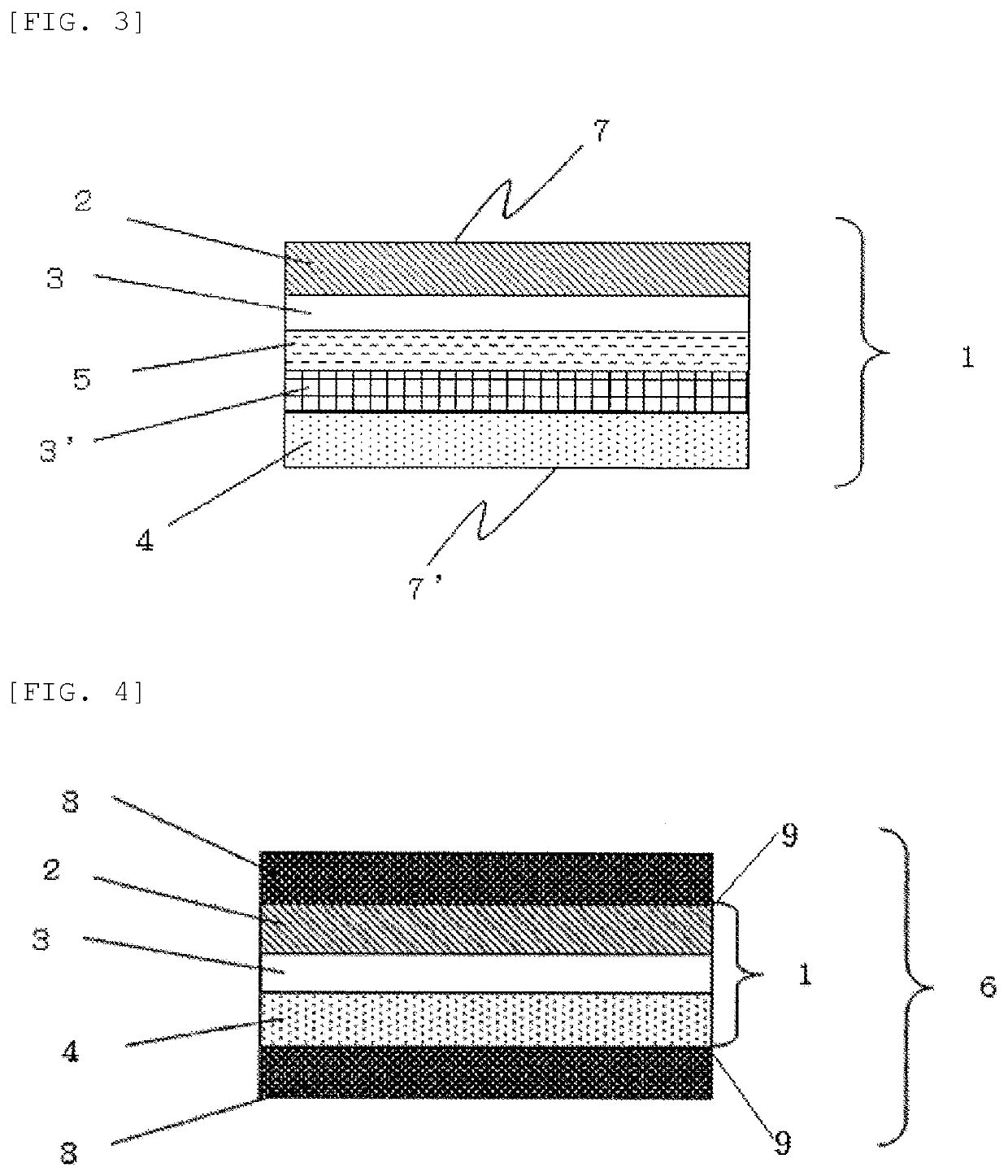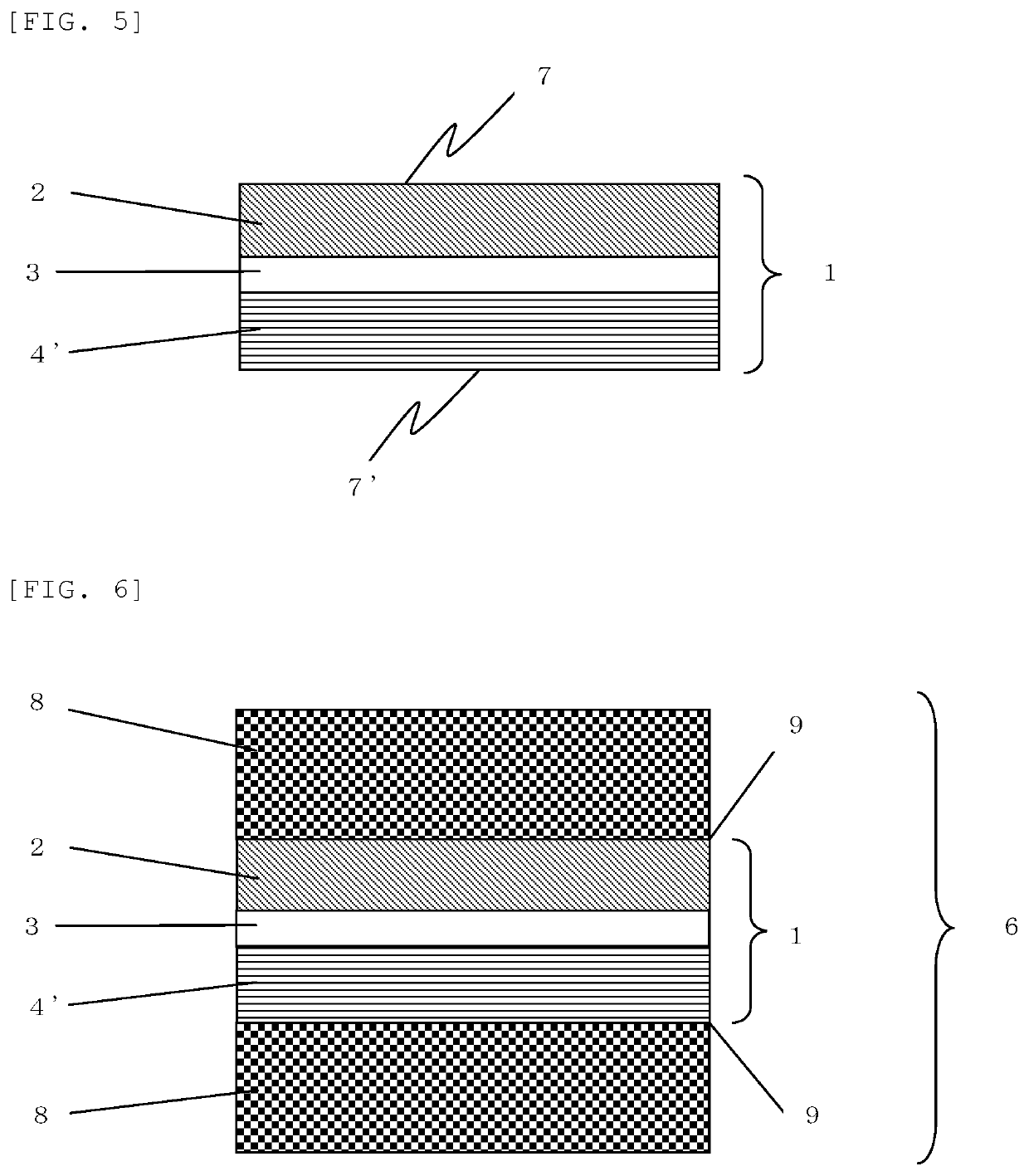Functional laminate and functional lens comprising the functional laminate
a functional laminate and functional technology, applied in the field of functional laminates and functional lenses comprising functional laminates, can solve the problems of unsatisfactory adhesives between thermosetting resin layers or synthetic resin layers as the base material and optical sheets having photochromic, appearance defects such as whitening or yellowing, and achieve excellent adhesion, high adhesion, and high adhesion
- Summary
- Abstract
- Description
- Claims
- Application Information
AI Technical Summary
Benefits of technology
Problems solved by technology
Method used
Image
Examples
example 1
(1) Surface Treatment of Precursor of Functional Laminate (A1); Production of Functional Laminate (A1)
[0378]The precursor of the functional laminate (A1) was cut into a circular shape having a diameter of 65 mm, and the obtained circular piece was immersed in a tank filled with a 20% KOH solution (mixture of distilled water and benzyl alcohol in a weight ratio of 90 / 10) heated at 50° C. to be ultrasonically cleaned for 10 minutes. Then, the etched precursor of the functional laminate (A1) was cleaned with running water and then in a distilled water tank heated at 50° C. and further in another distilled water tank heated at 50° C. to obtain the functional laminate (A1).
[0379]The surface treated functional laminate (A1) had a carboxyl group and an amino group on the outer surface and a contact angle of 43°. The analysis of the reactive functional groups on the outer surface was carried out by using the Spectrum One Fourier transform infrared spectral hardness meter of PERKINELMER INC....
example 22
[Production of Functional Laminate (A)]
[0432]The adhesive composition 4 was applied to the optical sheet 1 by using a bar coater and dried at 80° C. for 5 minutes to form an adhesive layer made of the adhesive composition 4 and having a thickness of 40 μm, and then the optical sheet 2 was bonded to this adhesive layer with a laminating roll.
[0433]Then, the structure obtained by the above method was left to stand at 60° C. under vacuum (500 Pa) for 12 hours (degassing step) and heated at 90° C. for 1 hour (heating step). Thereafter, it was left at room temperature for about one week to obtain a functional laminate (A10) having photochromic properties (may be simply referred to as “functional laminate (A10)” hereinafter).
[0434]As for the photochromic properties of the obtained functional laminate A10, the luminous transmittance was 11.0%, the fading speed was 45 seconds, the luminous transmittance (before color development) was 40.8%, and the polarization degree (before color developm...
example 50
[0441]The functional laminate (A10) was set in a glass mold (0.00D, lens diameter of 70 mm, thickness of 3.0 mm) having a gasket. A mixture of a thiourethane-based monomer composition (43.5 parts by mass of dicyclohexylmethane-4,4′-diisocyanate, 43.5 parts by mass of isophorone diisocyanate, 63.0 parts by mass of 1,2-bis[(2-mercaptoethyl)thio]-3-mercaptopropane and 0.1 part by mass of dibutyltin dilaurate as a polymerization initiator) was injected onto the top and bottom of the functional laminate (A10) set in the glass mold, gradually heated from 35° C. to 130° C. in an air furnace over 12 hours and then kept at 130° C. for 0.5 hour to be polymerized. After the end of polymerization, the gasket and the mold were removed, and the polymerized product was put into an oven to be heated at 130° C. for 3 hours. The functional laminate (A10) was dried under vacuum at 80° C. and 13 Torr for 15 hours before use.
[0442]Thereafter, the outer wall of the molded product was polished with a ball...
PUM
| Property | Measurement | Unit |
|---|---|---|
| Force | aaaaa | aaaaa |
| Contact angle | aaaaa | aaaaa |
| Temperature | aaaaa | aaaaa |
Abstract
Description
Claims
Application Information
 Login to View More
Login to View More - R&D
- Intellectual Property
- Life Sciences
- Materials
- Tech Scout
- Unparalleled Data Quality
- Higher Quality Content
- 60% Fewer Hallucinations
Browse by: Latest US Patents, China's latest patents, Technical Efficacy Thesaurus, Application Domain, Technology Topic, Popular Technical Reports.
© 2025 PatSnap. All rights reserved.Legal|Privacy policy|Modern Slavery Act Transparency Statement|Sitemap|About US| Contact US: help@patsnap.com



